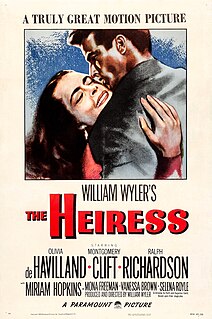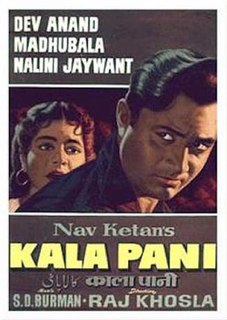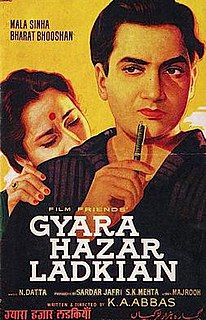Related Research Articles

The Heiress is a 1949 American romantic drama film directed and produced by William Wyler, from a screenplay written by Ruth and Augustus Goetz, adapted from their 1947 stage play of the same title, which was itself adapted from Henry James' 1880 novel Washington Square. The film stars Olivia de Havilland as Catherine Sloper, a naive young woman who falls in love with a handsome young man despite the objections of her emotionally abusive father who suspects the man of being a fortune hunter. Montgomery Clift stars as Morris Townsend, and Ralph Richardson as Dr. Sloper.

Shani Mootoo, writer, visual artist and video maker, was born in Dublin, Ireland, in 1957 to Trinidadian parents. She grew up in Trinidad and relocated at the age of 19 to Vancouver, British Columbia, Canada. She currently lives in Toronto, Ontario, Canada.

The Witch of Blackbird Pond is a children's novel by American author Elizabeth George Speare, published in 1958. The story takes place in late-17th century New England. It won the Newbery Medal in 1959.
Meet the Browns is a play written by Tyler Perry in 2004. It stars David & Tamela Mann as Mr. Brown & Cora, as they head off to see Brown's side of the family. The play is a spin off of 2003's Madea's Class Reunion, where it's revealed at the ending that Brown is Cora's long-lost father.

The Little Princess is a 1917 American silent film directed by Marshall Neilan based upon the 1905 novel A Little Princess by Frances Hodgson Burnett. This version is notable for having been adapted by famed screenwriter Frances Marion.

Kati Patang is a 1971 Indian Hindi-language musical drama film produced and directed by Shakti Samanta. It was a box office success. The film stars Asha Parekh as a woman pretending to be a widow, and her ensuing trials and tribulations opposite her charming neighbour, played by Rajesh Khanna. Parekh's performance as Madhavi was critically acclaimed and earned her a Filmfare Award for Best Actress.

The Black Moth (1921) is a Georgian era romance novel by the British author Georgette Heyer, set around 1751. The Black Moth was Heyer's debut novel, published when Heyer was nineteen. It was a commercial success.

My Cousin Rachel is a novel by British author Daphne du Maurier, published in 1951. Like the earlier Rebecca, it is a mystery-romance, set primarily on a large estate in Cornwall.

Princess Sara, also spelled as Princess Sarah, is a Japanese anime series produced by Nippon Animation, based on Frances Hodgson Burnett's 1905 novel, A Little Princess. Spanning 46 episodes, it originally premiered in 1985 across Japan on Fuji Television as the 11th series of Nippon Animation's World Masterpiece Theater.

Kala Pani is a 1958 Indian Hindi-language thriller film, produced by Dev Anand for Navketan Films and directed by Raj Khosla. It is a remake of the 1955 Bengali film Sabar Uparey which itself was based on A.J. Cronin's 1953 novel Beyond This Place. The film's music is by S. D. Burman, and the lyrics are by Majrooh Sultanpuri.

Princess Sarah is a 2007 Philippine television series based on the 1985 Japanese anime series of the same title, produced by Nippon Animation and based on Frances Hodgson Burnett's novel A Little Princess. It is topbilled by Sharlene San Pedro as Sarah Crewe. The series was aired on ABS-CBN's Primetime Bida evening block and worldwide on The Filipino Channel from November 12, 2007 to December 21, 2007, replacing Kokey.

Sanjog (transl. Destiny) is a 1972 Indian Hindi-language drama film directed by S. S. Balan. The film stars Mala Sinha, Amitabh Bachchan and Aruna Irani in the lead roles. It is a remake of the Tamil film Iru Kodugal directed by K. Balachander.

Uncle Bun is a 1991 Indian Malayalam-language film written and directed by Bhadran, and starring Mohanlal in the title role, as an obese youngster. The film is a remake of the 1989 film Uncle Buck.

Dil-e-Nadaan is a 1982 Indian Hindi-language romance film directed by C. V. Sridhar. The film stars Rajesh Khanna, Shatrughan Sinha, Jaya Prada and Smita Patil. It is a remake of Sridhar's 1978 Tamil film Ilamai Oonjal Aadukirathu.
Bewaqoof is a 1960 Indian film.

Zachariayude Garbhinikal is a Malayalam–language comedy-drama film written and directed by Aneesh Anwar. The film narrates the incidents in the life of a gynaecologist Dr.Zacharia and five women who come into his life. Lal appears as the gynaecologist while Rima Kallingal, Sanusha, Geetha, Asha Sarath, and Sandra Thomas play the roles of five pregnant women. Sandra Thomas also produced the film along with her father Thomas Joseph Pattathanam under the banner of Friday Cinema House. The film started production in May 2013 from Kochi, Kerala.

Gyara Hazar Ladkian is a 1962 Indian Hindi-language romantic social drama film directed by K. A. Abbas. The film was co-produced by the poet Ali Sardar Jafri, who also helped co-write the story with Abbas. Produced under the Film Friends banner, it had music by N. Datta. The director of photography was Ramchandra. The cast included Bharat Bhushan, Mala Sinha, Murad, Nadira and Helen.

Valmiki's Daughter is a novel by Shani Mootoo published in 2008. Nominated for the 2009 Scotiabank Giller Prize. and set in the modern-day Caribbean, the book features vivid depictions of culture drawn from Mootoo’s own background as a Trinidadian author. The book’s unique perspective on storytelling alternates between Valmiki, a renowned doctor, and his daughter, Viveka. Both are closeted homosexuals, struggling to cope with the pressure of growing up in a homophobic environment.

Once and for All is the fourteenth novel by Sarah Dessen. It was published in hardcover on June 6, 2017 and in paperback on May 22, 2018. According to Dessen's website, she was worried she no longer had anything to say after her novel Saint Anything was released in 2015. Surrounded by two people planning weddings and their desire for "wanting things to go perfectly," she felt something needed to be said about the amount of things in our lives we want to go "perfect". And so, Once and for All was written.
References
- ↑ Mootoo, Shani. 1996. Cereus Blooms at Night. New York: Avon Books.
- ↑ Kyungwon Hong, G. "'A Shared Queerness': Colonialism, Transnationalism, and Sexuality in Shani Mootoo's Cereus Blooms at Night." Meridians: feminism, race, transnationalism 7.1 (2006): 73-103.
- ↑ Non-resident Indian and Person of Indian Origin
- ↑ Yang, June Unjoo. "Cereus Blooms at Night be Shani Mootoo, The Pagoda by Patricia Powell." The Women's Review of Books. Vl. 16, No 8, (May, 1999(, pp11-12 Old CIty Publishing, Inc. <https://www.jstor.org/stable/4023191
- 1 2 May, Vivian M. "Trauma in Paradise: Willful and Strategic Ignorance in Cereus Blooms at Night." Hypatia Vol 21, No 3 (Summer 2006)
- ↑ May, Vivian M. "Trauma in Paradise: Willful and Strategic Ignorance in Cereus Blooms at Night." Hypatia Vol 21, No 3 (Summer 2006)